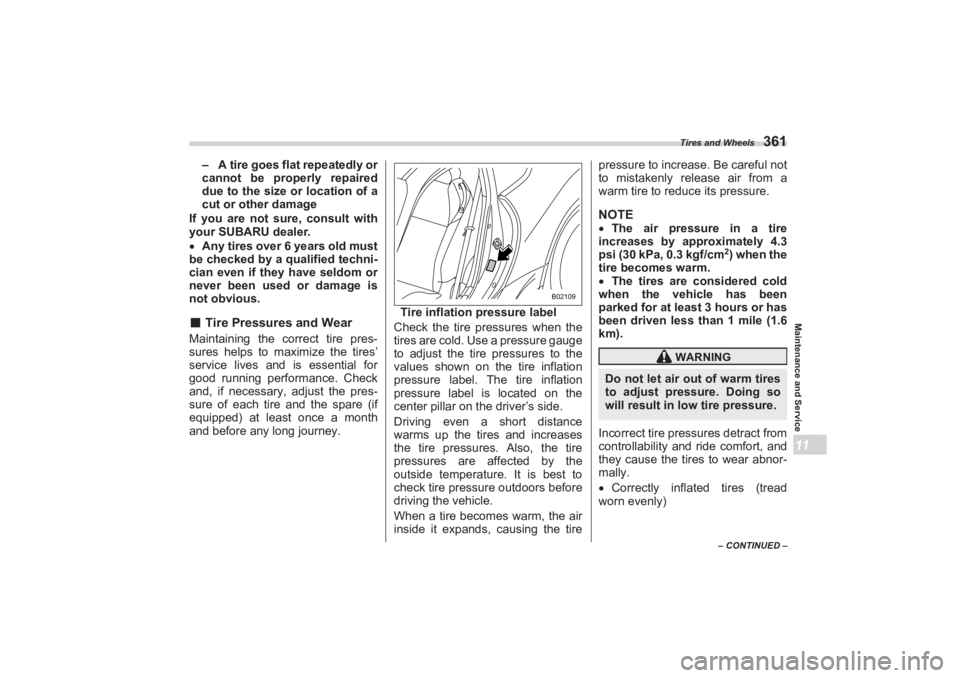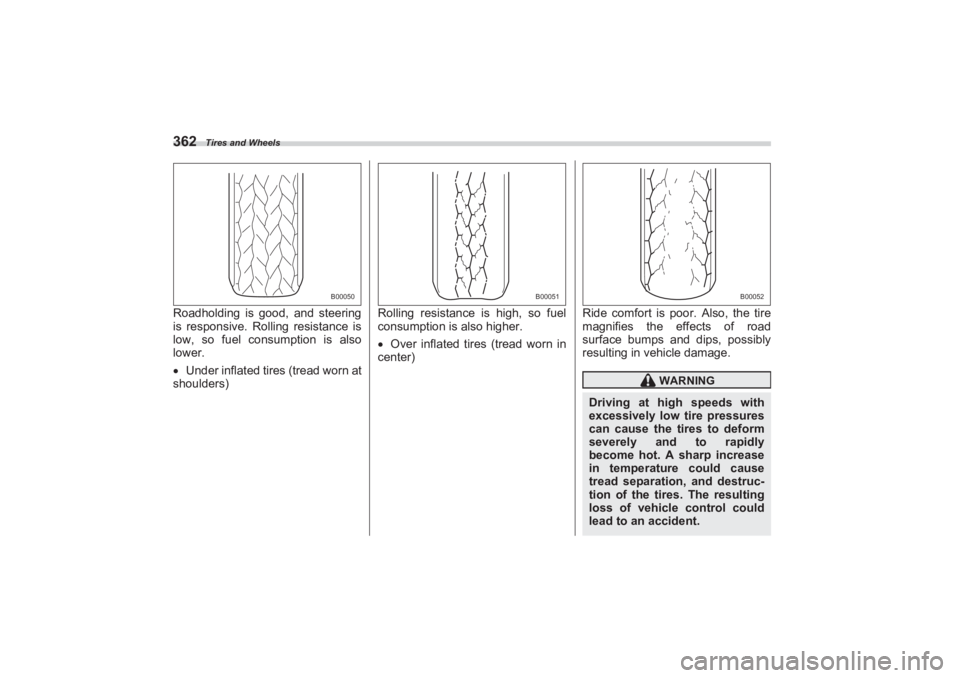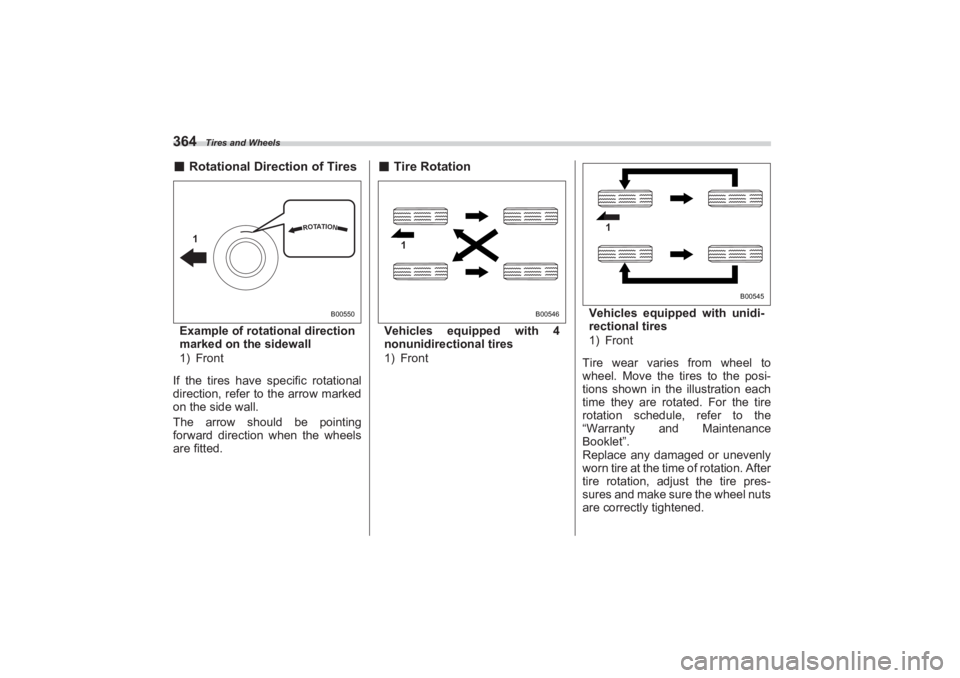2023 SUBARU BRZ tires
[x] Cancel search: tiresPage 343 of 432

Maintenance and Service11
Maintenance and Service
11-1. Maintenance Schedule .....................................339
11-2. Maintenance Precautions.................................339
Before Checking or Servicing in the Engine
Compartment ..............................................................340
When Checking or Servicing in the Engine Compartment ..............................................................340
When Checking or Servicing in the Engine Compartment While the Engine Is Running ............341
11-3. Maintenance Tips ..............................................341
Removing and Reinstalling Clips................................341
11-4. Engine Hood ......................................................343
11-5. Engine Compartment Overview.......................345
11-6. Engine Oil ..........................................................346
Engine Oil Consumption..............................................346
Checking the Oil Level .................................................346
Changing the Oil and Oil Filter ....................................347
Recommended Grade and Viscosity ..........................347
Synthetic Oil..................................................................348
11-7. Cooling System .................................................348
Cooling Fan, Hose and Connections ..........................348
Engine Coolant .............................................................349
11-8. Air Cleaner Element ..........................................350
Replacing the Air Cleaner Element .............................350
11-9. Spark Plugs .......................................................352
Recommended Spark Plugs ........................................352
11-10. Drive Belt .........................................................352
11-11. Automatic Transmission Fluid ......................352
Recommended Grade and Viscosity ..........................352
11-12. Differential Gear Oil ........................................353
Recommended Grade and Viscosity ..........................353
11-13. Manual Transmission Oil ...............................353
Recommended Grade and Viscosity ..........................353
11-14. Brake Fluid ......................................................353
Checking the Fluid Level ............................................ 353
Recommended Brake Fluid ........................................ 354
11-15. Clutch Fluid (MT models) ...............................354
Checking the Fluid Level ............................................ 354
Recommended Clutch Fluid ....................................... 355
11-16. Brake Booster .................................................355
11-17. Brake Pedal .....................................................356
11-18. Clutch Pedal (MT models) ..............................356
11-19. Replacement of Brake Pad and Lining..........356
Breaking-in of New Brake Pads and Linings ............ 357
11-20. Parking Brake Stroke ......................................357
11-21. Tires and Wheels ............................................358
Types of Tires .............................................................. 358
Tire Pressure Monito ring System (TPMS)
(If Equipped)............................................................... 358
Tire Inspection ............................................................. 360
Tire Pressures and Wear............................................. 361
Wheel Balance ............................................................. 363
Wear Indicators ............................................................ 363
Rotational Direction of Tires....................................... 364
Tire Rotation................................................................. 364
Tire Replacement ...... ............................. ...................... 365
Wheel Replacement ..................................................... 365
11-22. Alloy Wheels ....................................................366
11-23. Windshield Washer Fluid ...............................366
11-24. Replacement of Wiper Blades........................367
Windshield Wiper Blade Assembly ............................ 368
Windshield Wiper Blade Rubber ................................ 369
11-25. Battery ..............................................................370
11-26. Fuses ................................................................371
11-27. Installation of Acce ssories ............................373
BRZ_U.book 337 ページ 2022年3月29日 火曜日 午後3時59分
Page 364 of 432

Tires and Wheels
35811-21. Tires and Wheels■Types of TiresYou should be familiar with type of tires
present on your vehicle.
▼ Summer tires
The factory-installed tires on your new
vehicle are summer tires.
Summer tires are high-speed capability
tires best suited for highway driving under
dry conditions.
Summer tires are inadequate for driving
on slippery roads such as on snow-
covered or icy roads.
If you drive your vehicle on snow-covered
or icy roads, we strongly recommend the
use of winter (snow) tires.
When installing winter tires, be sure to
replace all four tires.
▼ All season tires
All season tires are designed to provide
an adequate measure of traction, handling
and braking performance in year-round
driving including snowy and icy road
conditions. However all season tires do
not offer as much traction performance as
winter (snow) tires in heavy or loose snow
or on icy roads. All season tires are identified by “ALL
SEASON” and/or “M+S” (Mud & Snow) on
the tire sidewall.
▼ Winter (snow) tires
Winter tires are best suited for driving on
snow-covered and icy roads. However
winter tires do not perform as well as
summer tires and all season tires on roads
other than snow-covered and icy roads.
NOTEIf the tread wears down below 0.16 in.
(4mm) on snow tires the effectiveness
of snow tires is lost.
▼ Low profile tires
Generally, low profile tires will wear more
rapidly and tire grip performance will be
reduced on snowy and/or icy roads when
compared to standard tires. Be sure to
use snow tires or tire chains on snowy
and/or icy roads and drive carefully at a
speed appropriate for road and weather
conditions.NOTELow profile tires may cause greater
damage than usual to the wheel when
receiving impact from the road sur-
face. Therefore pay attention to the fol-
lowing:
Be sure to use proper tire inflation
pressure. If tires are under-inflated,
they may be damaged more severely.
Avoid pot holes, uneven pavement,
curbs and other road hazards. Failure
to do so may lead to severe tire and
wheel damage.
■ Tire Pressure Monitoring
System (TPMS) (If Equipped)The tire pressure monitoring system
provides the driver with a warning
message by sending a signal from a
sensor that is installed in each wheel
when tire pressure is severely low. The
tire pressure monitoring system will acti-
vate only when the vehicle is driven. Also,
this system may not react immediately to
a sudden drop in tire pressure (for
example, a blow-out caused by running
over a sharp object).
If you adjust the tire pressures in a warm
garage and will then drive the vehicle in
cold outside air, the resulting drop in tire
pressures may cause the low tire pressure
warning light to illuminate. To avoid this
problem when adjusting the tire pressures
in a warm garage, inflate the tires to pres-
sures higher than those shown on the tire
inflation pressure label. Specifically,
inflate them by an extra 1 psi (6.9 kPa,
0.07 kgf/cm
2) for every difference of 10°F
BRZ_U.book 358 ページ 2022年3月29日 火曜日 午後3時59分
Page 365 of 432

Tires and Wheels
359
Maintenance and Service11
– CONTINUED –
(5.6°C) between the temperature in the
garage and the temperature outside. By
way of example, the following table shows
the required tire pressures that corre-
spond to various outside temperatures
when the temperature in the garage is
60°F (15.6°C).
Example:
Tire size: 215/40R18 85Y
Standard tire pressures:
Front: 35 psi (240 kPa, 2.4 kgf/cm
2)
Rear: 35 psi (240 kPa, 2.4 kgf/cm2)
Garage temperature: 60°F (15.6°C)
Example:
Tire size: 215/45R17 87W
Standard tire pressures:
Front: 35 psi (240 kPa, 2.4 kgf/cm2)
Rear: 35 psi (240 kPa, 2.4 kgf/cm2)
Garage temperature: 60°F (15.6°C) If the low tire pressure warning light illumi-
nates when you drive the vehicle in cold
outside air after adjusting the tire pres-
sures in a warm garage, re-adjust the tire
pressures using the method described
above. Then, increase the vehicle speed
to at least 25mph (40km/h) and check to
see that the low tire pressure warning light
goes off a few minutes later. If the low tire
pressure warning light does not go off, the
tire pressure monito ring system may not
be functioning normally. In this event, go
to a SUBARU dealer to have the system
inspected as soon as possible.
While the vehicle is driven, friction
between tires and the road surface
causes the tires to warm up. After illumi-
nation of the low tire pressure warning
light, any increase in the tire pressures
caused by an increase in the outside air
temperature or by an increase in the
temperature in the tires can cause the low
tire pressure warning light to go off. System resetting is
necessary when the
wheels are changed (for example, a
switch to snow tires) and new TPMS
valves are installed on the newly fitted
wheels. Have this work performed by a
SUBARU dealer following wheel replace-
ment.
It may not be possible to install TPMS
valves on certain wheels that are on the
market. Therefore, if you change the
wheels (for example, a switch to snow
tires), use wheels that have the same part
number as the standard-equipment
wheels. Without four operational TPMS
valve/sensors on the wheels, the TPMS
will not fully function and the warning light
in the instrument panel will illuminate
steadily after blinking for approximately
one minute.
When a tire is replaced, adjustments are
necessary to ensure continued normal
operation of the tire pressure monitoring
system. As with wheel replacement,
therefore, you s hould have the work
performed by a SUBARU dealer.
Outside
temperature Adjusted pressure
[psi (kPa, kgf/cm
2)]
Front Rear
30°F ( −1°C) 38 (260, 2.6) 38 (260, 2.6)
10°F ( −12°C) 40 (275,
2.75) 40 (275,
2.75)
− 10°F
( − 23°C) 42 (290, 2.9) 42 (290, 2.9)
Outside
temperature Adjusted pressure
[psi (kPa, kgf/cm
2)]
Front Rear
30°F ( −1°C) 38 (260, 2.6) 38 (260, 2.6)
10°F ( −12°C) 40 (275,
2.75) 40 (275,
2.75)
− 10°F
( − 23°C) 42 (290, 2.9) 42 (290, 2.9)
BRZ_U.book 359 ページ 2022年3月29日 火曜日 午後3時59分
Page 366 of 432

Tires and Wheels
360
■Tire InspectionCheck on a daily basis that the tires
are free from serious damage, nails,
and stones. At the same time, check
the tires for abnormal wear.
Contact your SUBARU dealer
immediately if you find any problem.NOTE When the wheels and tires
strike curbs or are subjected to
harsh treatment as when the
vehicle is driven on a rough surface, they can suffer damage
that cannot be seen with the
naked eye. This type of damage
does not become evident until
time has passed. Try not to drive
over curbs, potholes or on other
rough surfaces. If doing so is
unavoidable, keep the vehicle’s
speed down to a walking pace or
less, and approach the curbs as
squarely as possible. Also, make
sure the tires are not pressed
against the curb when you park
the vehicle.
If you feel unusual vibration
while driving or fi nd it difficult to
steer the vehicle in a straight line,
one of the tires and/or wheels
may be damaged. Drive slowly to
the nearest authorized SUBARU
dealer and have the vehicle
inspected.
Tires should be replaced if:
– You have tire damage such
as cuts, splits, cracks deep
enough to expose the fabric or
bulges indicating internal
damage
WARNING
If the low tire pressure warning light
does not illuminate briefly after the
ignition switch is turned ON or the
light illuminates steadily after blink-
ing for approximately one minute,
you should have your Tire Pressure
Monitoring System checked at a
SUBARU dealer as so on as possi-
ble.If this light illuminates while driving,
never brake suddenly. Instead, per-
form the following procedure. Oth-
erwise an accident involving
serious vehicle damage and serious
personal injury could occur.1) Keep driving straight ahead while
gradually reducing speed.2) Slowly pull off the road to a safe
place.If this light still illuminates while
driving after adjusting the tire pres-
sure, a tire may have significant
damage and a fast leak that causes
the tire to lose ai r rapidly. If you
have a flat tire, re fer to "Flat Tires"
P303.
When a spare tire is mounted or a
wheel rim is replaced without the
original pressure sensor/transmitter
being transferred, the low tire pres-
sure warning light will illuminate
steadily after blinking for approxi-
mately one minute. This indicates
the TPMS is unable to monitor all
four road wheels. Contact your
SUBARU dealer as soon as possi-
ble for tire and sensor replacement
and/or system resetting. If the light
illuminates steadily after blinking
for approximately one minute,
promptly contact a SUBARU dealer
to have the system inspected.
BRZ_U.book 360 ページ 2022年3月29日 火曜日 午後3時59分
Page 367 of 432

Tires and Wheels
361
Maintenance and Service11
– CONTINUED –
– A tire goes flat repeatedly or
cannot be properly repaired
due to the size or location of a
cut or other damage
If you are not su re, consult with
your SUBARU dealer.
Any tires over 6 years old must
be checked by a qualified techni-
cian even if they have seldom or
never been used or damage is
not obvious.
■ Tire Pressures and WearMaintaining the correct tire pres-
sures helps to maximize the tires’
service lives and is essential for
good running performance. Check
and, if necessary, adjust the pres-
sure of each tire and the spare (if
equipped) at least once a month
and before any long journey. Tire inflation pressure label
Check the tire pressures when the
tires are cold. Use a pressure gauge
to adjust the tire pressures to the
values shown on the tire inflation
pressure label. The tire inflation
pressure label is located on the
center pillar on the driver’s side.
Driving even a short distance
warms up the tires and increases
the tire pressures. Also, the tire
pressures are affected by the
outside temperature. It is best to
check tire pressure outdoors before
driving the vehicle.
When a tire becomes warm, the air
inside it expands, causing the tire pressure to increase. Be careful not
to mistakenly release air from a
warm tire to reduce its pressure.
NOTE The air pressure in a tire
increases by approximately 4.3
psi (30 kPa, 0.3 kgf/cm
2) when the
tire becomes warm.
The tires are considered cold
when the vehicle has been
parked for at least 3 hours or has
been driven less than 1 mile (1.6
km).
Incorrect tire pressures detract from
controllability and ride comfort, and
they cause the tires to wear abnor-
mally.
Correctly inflated tires (tread
worn evenly)
B02109
WARNING
Do not let air out of warm tires
to adjust pressure. Doing so
will result in low tire pressure.
BRZ_U.book 361 ページ 2022年3月29日 火曜日 午後3時59分
Page 368 of 432

Tires and Wheels
362Roadholding is good, and steering
is responsive. Rolling resistance is
low, so fuel consumption is also
lower.
Under inflated tires (tread worn at
shoulders) Rolling resistance is high, so fuel
consumption is also higher.
Over inflated tires (tread worn in
center) Ride comfort is poor. Also, the tire
magnifies the effects of road
surface bumps and dips, possibly
resulting in vehicle damage.
B00050
B00051
WARNING
Driving at high speeds with
excessively low tire pressures
can cause the tires to deform
severely and to rapidly
become hot. A sharp increase
in temperature could cause
tread separation, and destruc-
tion of the tires. The resulting
loss of vehicle control could
lead to an accident.
B00052
BRZ_U.book 362 ページ 2022年3月29日 火曜日 午後3時59分
Page 369 of 432

Tires and Wheels
363
Maintenance and Service11
– CONTINUED –
■Wheel BalanceEach wheel was correctly balanced
when your vehicle was new, but the
wheels will become unbalanced as
the tires become worn during use.
Wheel imbalance causes the
steering wheel to vibrate slightly at
certain vehicle speeds and detracts
from the vehicle’s straight-line
stability. It can also cause steering
and suspension system problems
and abnormal tire wear. If you
suspect that the wheels are not
correctly balanced, have them
checked and adjusted by your
SUBARU dealer. Also have them
adjusted after tire repairs and after
tire rotation.
NOTEThe suspension system is
designed to hold each wheel at a
certain alignment (relative to the
other wheels and to the road) for
optimum straight-line stability
and cornering performance.■ Wear Indicators1) New tread
2) Worn tread3)
Tread wear indicator
Each tire incorporates a tread wear
indicator, which becomes visible
when the depth of the tread grooves
decreases to 0.063 in (1.6 mm). A tire must be replaced when the
tread wear indicator appears as a
solid band across the tread.
NOTEFor safety, inspect the tire tread
regularly and replace the tires
before their tread wear indicators
become visible.
CAUTION
Loss of correct wheel align-
ment causes the tires to wear
on one side and reduces the
vehicle’s running stability.
Contact your SUBARU dealer
if you notice abnormal tire
wear.
12 3
B00327
WARNING
When a tire’s tread wear indi-
cator becomes visible, the tire
is worn beyond the accept-
able limit and must be
replaced immediately. With a
tire in this condition, driving at
high speeds in wet weather
can cause the vehicle to
hydroplane. The resulting loss
of vehicle control can lead to
an accident.
BRZ_U.book 363 ページ 2022年3月29日 火曜日 午後3時59分
Page 370 of 432

Tires and Wheels
364■Rotational Direction of TiresExample of rotational direction
marked on the sidewall
1) Front
If the tires have specific rotational
direction, refer to the arrow marked
on the side wall.
The arrow should be pointing
forward direction when the wheels
are fitted.
■ Tire RotationVehicles equipped with 4
nonunidirectional tires
1) Front Vehicles equipped with unidi-
rectional tires
1) Front
Tire wear varies from wheel to
wheel. Move the tires to the posi-
tions shown in the illustration each
time they are rotated. For the tire
rotation schedule, refer to the
“Warranty and Maintenance
Booklet”.
Replace any damaged or unevenly
worn tire at the time of rotation. After
tire rotation, adjust the tire pres-
sures and make sure the wheel nuts
are correctly tightened.
ROTATION
1
B00550
1
B00546
1
B00545
BRZ_U.book 364 ページ 2022年3月29日 火曜日 午後3時59分